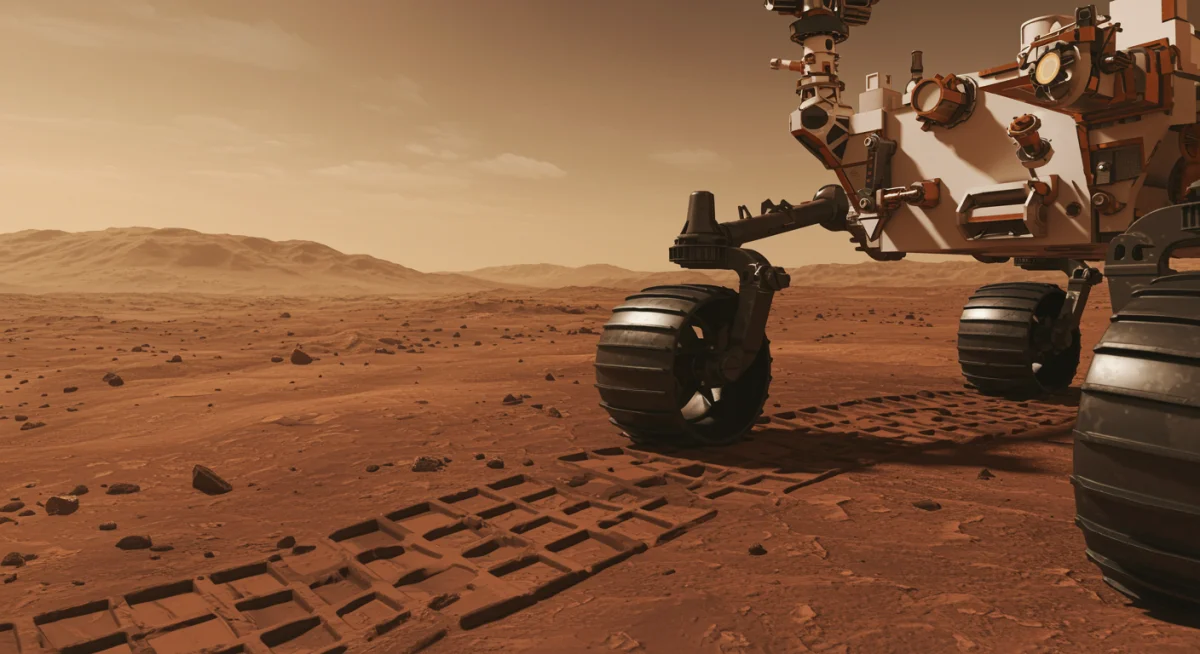NASA’s Mars Mission Updates: 2025 Launch Schedule & Exploration News

NASA’s Mars Mission Updates: 2025 Launch Schedule and ongoing exploration efforts are pivotal to understanding the Red Planet’s past, present, and potential for future human habitation.
The allure of the Red Planet continues to captivate scientists and the public alike, driving forward an ambitious agenda of space exploration. As we look towards the near future, the latest NASA Mars Missions 2025 present a thrilling chapter in humanity’s quest to unravel the mysteries of our celestial neighbor. This article delves into the critical updates, planned launches, and the groundbreaking science set to unfold.
The Vision for Mars: Beyond Robotic Exploration
NASA’s long-term vision for Mars extends far beyond the current robotic explorers. The agency is meticulously laying the groundwork for eventual human missions, a monumental undertaking that necessitates a deep understanding of the Martian environment. This includes studying its geology, atmosphere, and potential for resources.
The data collected by current and future missions is crucial for developing technologies and strategies to ensure astronaut safety and mission success. Every rover, orbiter, and lander contributes a piece to this complex puzzle, bringing us closer to the day humans walk on Mars.
Preparing for Human Habitation
Preparing for human habitation on Mars involves overcoming immense challenges, from radiation exposure to resource utilization. NASA’s approach is multi-faceted, focusing on incremental advancements that build upon each other.
- ISRU Technologies: In-Situ Resource Utilization (ISRU) is key, focusing on using local Martian resources like water ice to produce oxygen and rocket fuel.
- Radiation Shielding: Developing effective shielding for spacecraft and habitats is paramount to protect astronauts from harmful cosmic and solar radiation.
- Life Support Systems: Advanced closed-loop life support systems are essential for long-duration missions, minimizing reliance on resupply from Earth.
These preparatory steps are not just theoretical; they are being actively researched and tested through various Earth-based analogs and increasingly sophisticated robotic missions. The insights gained from missions like Perseverance are directly informing these critical developments, making the dream of human presence on Mars a tangible goal.
Ultimately, the overarching goal is to establish a sustainable human presence on Mars, enabling scientific research and expanding humanity’s reach across the solar system. This ambitious endeavor requires international collaboration and continuous technological innovation, pushing the boundaries of what is currently possible.
Current Mars Missions: A Legacy of Discovery
Before looking ahead to 2025, it’s essential to acknowledge the incredible work being done by NASA’s current fleet of Martian explorers. These missions have redefined our understanding of the Red Planet, providing unprecedented data and breathtaking imagery. Each spacecraft plays a unique role in the ongoing saga of Martian discovery.
From the persistent Spirit and Opportunity rovers of yesteryear to the highly advanced Perseverance, these robotic ambassadors have meticulously surveyed the Martian landscape. Their findings have confirmed the presence of ancient water, identified organic molecules, and provided critical insights into Mars’ geological history.
Perseverance Rover and Ingenuity Helicopter
The Perseverance rover, which landed in Jezero Crater in February 2021, is at the forefront of NASA’s Mars exploration. Its primary mission is to seek signs of ancient microbial life, collect Martian rock and regolith samples, and test technologies for future human exploration. Accompanying Perseverance is the Ingenuity helicopter, the first aircraft to achieve powered, controlled flight on another planet.
- Sample Caching: Perseverance is diligently collecting samples, sealing them in tubes for potential return to Earth by future missions. This sample return campaign is a cornerstone of Mars exploration.
- Atmospheric Studies: Its MOXIE instrument is successfully producing oxygen from the Martian atmosphere, a vital step for future human missions.
- Aerial Reconnaissance: Ingenuity has demonstrated the feasibility of aerial exploration, providing valuable scouting data for Perseverance and paving the way for more advanced Martian aircraft.
The data streaming back from Perseverance and Ingenuity continues to revolutionize our understanding of Mars. Their discoveries enrich our knowledge of the planet’s habitability and geological evolution, painting a more complete picture of its past and future potential.
The 2025 Mars Launch Window: What to Expect
The year 2025 is poised to be another significant period for Mars exploration, with NASA and its international partners preparing for new missions. The launch windows for Mars occur approximately every 26 months, dictated by the orbital mechanics of Earth and Mars. This synchronous alignment allows for the most fuel-efficient and shortest journeys.
While specific mission details are still being finalized, the 2025 window is expected to focus on advancing sample return efforts and testing new technologies for human exploration. These missions will build upon the successes and lessons learned from previous endeavors, pushing the boundaries of what’s possible.
Key Objectives for Future Missions
Future missions, including those slated for 2025, will likely have several overarching objectives. These goals are carefully chosen to address critical scientific questions and technological hurdles necessary for sustainable human presence.
- Martian Sample Return: A major focus will be the Mars Sample Return (MSR) campaign, aiming to bring the samples collected by Perseverance back to Earth for in-depth analysis. This is a multi-mission effort involving a Sample Retrieval Lander and an Earth Return Orbiter.
- Advanced Resource Utilization: Further testing of ISRU technologies will be crucial. This includes refining methods for extracting water and oxygen from the Martian environment.
- Habitat Prototyping: Missions may include components designed to test rudimentary habitat technologies or construction techniques on the Martian surface.
The planning for these missions is a complex, multi-year process involving thousands of engineers and scientists. Each component must be rigorously tested and designed to withstand the harsh conditions of space travel and the Martian environment. The 2025 window represents a critical next step in this long-term strategy.
Technological Innovations Driving Mars Exploration
The ambitious goals of NASA’s Mars missions, particularly those planned for 2025, are only achievable through continuous technological innovation. From advanced propulsion systems to sophisticated scientific instruments, each new development pushes the boundaries of space exploration. These innovations are not just about reaching Mars; they are about understanding it more deeply and safely.
One of the most significant areas of development is in autonomous systems. Given the communication delay between Earth and Mars, future rovers and landers will require even greater levels of independence to react to unexpected situations and optimize their scientific investigations without constant human input.
Next-Generation Instruments and AI
Future missions will incorporate even more advanced scientific instruments, capable of unprecedented levels of analysis. These instruments, often miniaturized and more robust, will allow for detailed studies of Martian geology, atmospheric composition, and potential biosignatures.
- AI-Powered Navigation: Artificial intelligence will play an increasing role in autonomous navigation, hazard avoidance, and optimizing scientific observations on Mars.
- Enhanced Spectroscopy: New spectroscopic tools will provide more precise chemical and mineralogical analysis of Martian rocks and soil, aiding in the search for past life.
- Miniaturized Sensors: Smaller, more efficient sensors will allow for a greater diversity of scientific payloads on future missions, maximizing data collection.
The integration of artificial intelligence and machine learning into mission operations will dramatically increase the efficiency and scientific return of future Mars endeavors. These technologies will enable quicker data analysis, more informed decision-making, and the ability to adapt to dynamic Martian conditions.
Challenges and Collaborative Efforts for 2025 Missions
Undertaking missions to Mars, especially those as complex as the 2025 proposed launches, is fraught with challenges. These aren’t just technical hurdles; they encompass logistical, financial, and even political considerations. Overcoming these obstacles requires ingenuity, perseverance, and a strong spirit of international collaboration.
The sheer distance to Mars means that missions must be incredibly robust and self-sufficient. There is no possibility of sending a repair crew if something goes wrong. Every component must be designed for extreme reliability and redundancy, adding to the complexity and cost of each mission.

International Partnerships
Recognizing the immense scale of Mars exploration, international partnerships have become increasingly vital. Collaborations with agencies like the European Space Agency (ESA) and other global entities pool resources, expertise, and technology, making ambitious projects more feasible.
- Resource Sharing: Partnering allows for the sharing of launch vehicles, scientific instruments, and ground support infrastructure, reducing individual agency costs.
- Diverse Expertise: International teams bring a wider range of scientific and engineering perspectives, leading to more innovative solutions to complex problems.
- Shared Risk: Distributing the risks associated with highly complex missions across multiple agencies enhances the overall resilience of the exploration program.
The Mars Sample Return campaign, for instance, is a prime example of such a partnership, with NASA and ESA working hand-in-hand to achieve this unprecedented scientific feat. This collaborative model is likely to be a defining characteristic of future Mars missions, including those in 2025, as humanity continues its journey to the Red Planet.
The Future Impact of Mars Exploration on Earth
While the immediate focus of Mars exploration is on understanding our neighboring planet, the implications for Earth are profound and far-reaching. The scientific discoveries, technological advancements, and the inspiration generated by these missions have a tangible impact on our lives here, fostering innovation and addressing global challenges.
The pursuit of knowledge on Mars pushes the boundaries of engineering and science, leading to breakthroughs that find applications in diverse fields, from medicine to environmental science. The investment in space exploration often yields unexpected and invaluable returns for society.
Spin-off Technologies and Inspiration
Many technologies developed for space missions have found their way into everyday products and services, leading to significant societal benefits. This trend is expected to continue with future Mars missions, including those in 2025.
- Medical Innovations: Miniaturized sensors and imaging technologies developed for spacecraft have applications in medical diagnostics and treatments.
- Environmental Monitoring: Techniques for analyzing planetary atmospheres and geology can be adapted for Earth-based environmental monitoring and resource management.
- STEM Education: Mars missions inspire new generations of scientists, engineers, and explorers, fueling interest in STEM fields and contributing to a skilled workforce.
Beyond the practical applications, Mars exploration embodies humanity’s innate drive to explore and understand our place in the universe. It unites people across borders and provides a sense of shared purpose, reminding us of what we can achieve when we work together towards a common, ambitious goal. The ongoing progress of NASA Mars Missions 2025 will undoubtedly continue this legacy of impact and inspiration.
| Key Mission Aspect | Brief Description |
|---|---|
| 2025 Launch Window | Optimal period for new missions to Mars due to orbital alignment. |
| Mars Sample Return (MSR) | Multi-mission campaign to bring Martian samples collected by Perseverance back to Earth. |
| ISRU Technologies | In-Situ Resource Utilization, focusing on using Martian resources like water ice for human missions. |
| International Collaboration | Key for sharing resources, expertise, and mitigating risks in complex missions. |
Frequently Asked Questions About Mars Missions
The primary goal for 2025 Mars missions is expected to focus on advancing the Mars Sample Return campaign, bringing collected samples to Earth, and further testing technologies critical for future human exploration, such as In-Situ Resource Utilization (ISRU).
Mars launch windows occur approximately every 26 months. This timing is crucial as it represents the most efficient period to send spacecraft from Earth to Mars, optimizing fuel consumption and travel time due to the planets’ orbital alignments.
The Perseverance rover is actively searching for signs of ancient microbial life, collecting rock and regolith samples for future return to Earth, and testing technologies like MOXIE for oxygen production, which are vital for human missions.
International collaboration is crucial for Mars missions because it allows for the pooling of resources, shared expertise, and the distribution of risks associated with complex and expensive endeavors. This collaborative approach enhances mission feasibility and scientific return.
Mars missions benefit Earth through technological spin-offs that find applications in various industries, medical advancements, and environmental monitoring. They also inspire future generations in STEM fields and foster global cooperation and a shared sense of human exploration.
Conclusion
The continuous flow of NASA Mars Missions 2025 updates underscores humanity’s unwavering commitment to unraveling the mysteries of the Red Planet. From the groundbreaking work of current rovers like Perseverance to the ambitious plans for sample return and human exploration in the coming years, each step brings us closer to a deeper understanding of Mars’ past habitability and its potential to host human life. The challenges are immense, but the spirit of innovation and international collaboration continues to drive progress, promising a future where Mars is not just a distant dream, but a tangible destination for humanity.





